Newsletter Valians Lipiec 2025
All posts by Valians
Październik 2025
Wrzesień 2025
Lipiec 2025
Maj 2025
Cedric Fromont becomes the sole shareholder and CEO of Valians International!
Kwiecień 2025
Luty 2025
Styczeń 2025
Listopad 2024
FOCUS: Major opportunities in Poland in 2024
We’ve compiled a document outlining the significant opportunities arising in Poland for 2024, covering various sectors and industries.
🛡️ Defense & Aerospace : Witness the surge in defense spending, with Poland leading NATO in military investment. Explore the aerospace cluster, home to industry giants.
🌿 Energy Revolution: Dive into Poland’s energy transformation boom, including ambitious plans for #renewableenergy – photovolatics and offshore wind farms, and the country’s first nuclear plant by 2033.
🏗️ Infrastructure : Experience the transformation with massive investments supported by EU funds in roadways, railways, and river navigation, and the New Solidarity Transportation Hub (STH) Mega project, spearheading growth in construction and green building.
🏥 Healthcare & Medtech Advancements: Tap into the healthcare sector, fueled by rising demand for medical devices, innovative treatments, and medical tourism.
💻 IT & Cybersecurity Hub: Poland’s tech ecosystem, boasting rapid growth in cybersecurity and IT services, with a thriving community of technology companies and unicorn startups.
The document is available here.
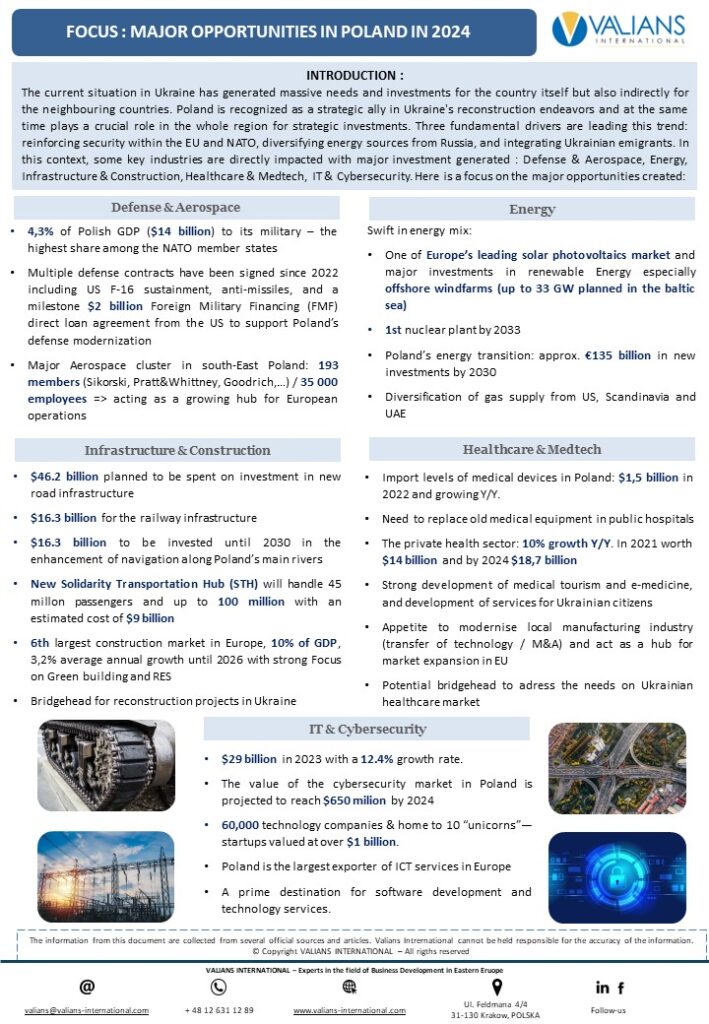
VALIANS HIGHLIGHTS IN 2023
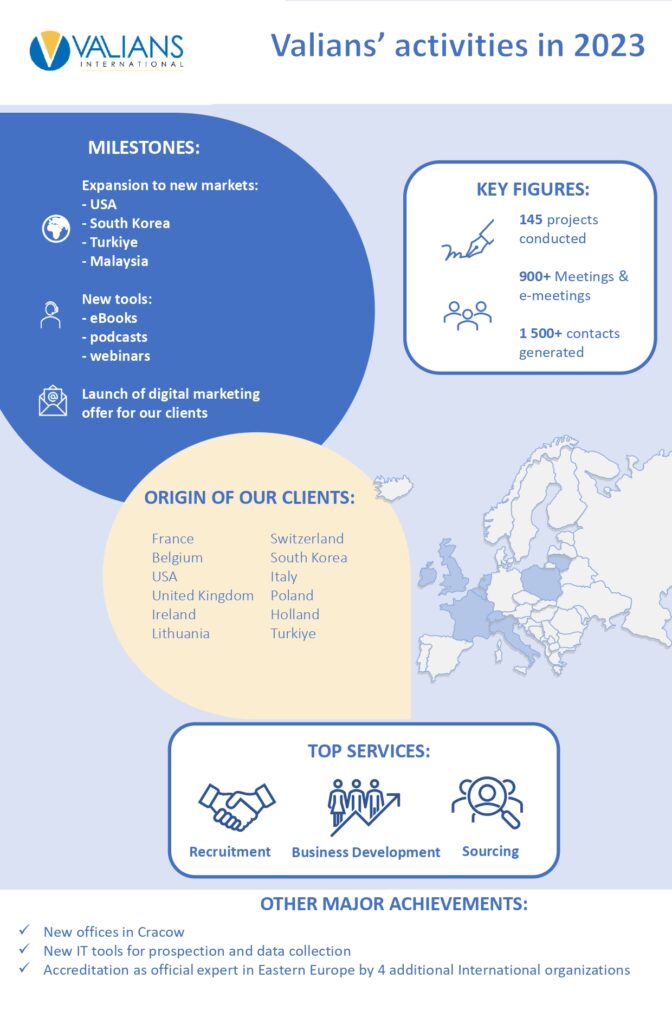
Overview of the key incentives for investment in 4 major CEE countries
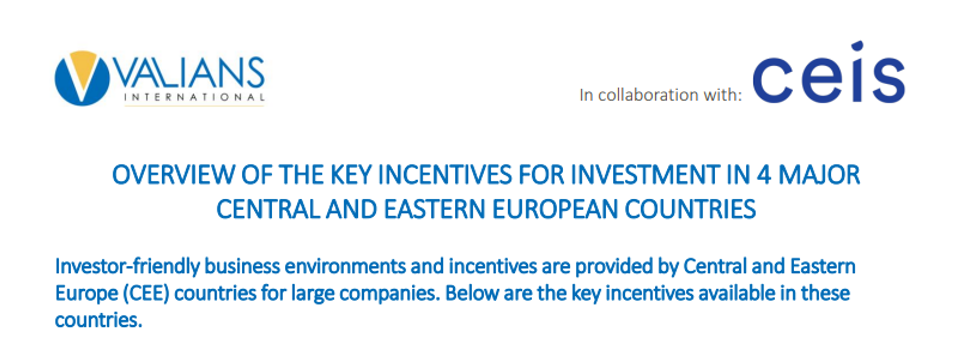
In-depth overwiev of the investment landscape in Central and Eastern Europe (CEE), with a particular focus on four countries: Poland, Slovakia, Hungary, and Serbia. These countries have positioned themselves as magnets for large companies, fostering investor-friendly business environments complemented by a suite of compelling incentives.
Favorable tax regimes, financial grants, and supportive policies form the pillars of encouragement for large-scale investments. The governments in these countries have recognized the importance of attracting substantial capital and have strategically crafted incentives to bolster economic growth and development.
To learn more read this article prepared by Valians International in cooperation with CEIS.
Newsletter Valians – Listopad 2023
Focus – Human Ressource Solutions in Eastern Europe
Optimizing long-term development in the Eastern European market can mean recruiting the right resources locally, whether they are managers, technical sales staff or even site directors. Poland has a wealth of highly qualified international profiles, fluent in several languages, capable of operating not only in Poland, but also in neighboring countries.
For more information, you can dowload this focus on human ressource solutions in Eastern Europe !
Any projects in Eastern Europe ? Contact us – valians@valians-international.com
Zaproszenie na Targi Texhibition Istanbul – 13 – 15 Wrzesień 2023
Zapraszamy w imieniu organizatorów targów Texhibition Istanbul na targi połączone z spotkaniami biznesowymi, w dniu 13-15 Wrzesień 2023, na które współorganizatorzy chcieliby zaprosić przedstawicieli polskich firmy.
Będzie to okazja do nawiązania relacji biznesowych potencjalnymi nowymi dostawcami z całego świata.
Jeśli chcesz dowiedzieć więcej odnośnie wydarzenia wejdź na oficjalną Broszurę targów
Jeśli jesteś zainteresowany skontaktuj się z nami: fhauptmann@valians-international.com
Focus on Business development solution in Poland
During international development, it is essential for a company to be aware of the available solutions and choose the one that best suits its situation. Outsourcing the sales force, also known as „business development” or „key account management,” can be an interesting option to consider. This focus discusses the relevance of this approach and the situations in which it can be implemented.
Any projects in Eastern Europe ? Contact us – valians@valians-international.com
Focus : Metal processing, plastic transformation, and electronic manufacturing in Eastern Europe
Valians International has supported over 50 companies in the past three years with their sourcing and nearshoring initiatives in Central and Eastern Europe. These projects have covered various sectors, such as metal processing, plastics transformation, and electronics. Here are a few examples illustrating the current situation of these industries in the region.
Any projects in Eastern Europe ? Contact us – valians@valians-international.com
Focus : Sourcing situation and trends in Eastern Europe
Since the beginning of the pandemic in 2020, the region has established itself as a key destination for nearshoring, benefiting from the trend of relocating sourcing and production operations. Through the analysis of the last 30 sourcing projects in Eastern Europe, you will find the success factors of these projects in the region.
For more information, you may download this focus on sourcing in Eastern Europe. Click here !
Any projects in Eastern Europe ? Contact us – valians@valians-international.com
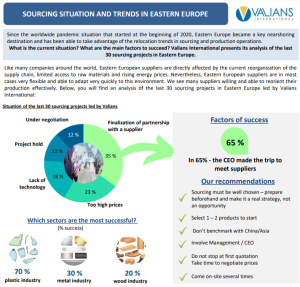
Focus : Human resources solutions by Valians
We offer human resources solutions for your development in Eastern Europe. From HR and salary comparative study to HR organizational audit and personalized recruitment services, we help you optimize your human resources management and find the best talents to ensure your long-term success.
For more information, you can download this focus on human resources in Eastern Europe. Click here !
Any projects in Eastern Europe ? Contact us – valians@valians-international.com
Cedric Fromont accredited as Foreign Trade Specialist for AWEX (Wallonia) for the next 3 years
This certification allows Walloon companies to use funding support to rely on our consulting and support services in their development in Eastern European countries (Poland, Czechia, Slovakia, Hungary, Romania, Bulgaria, Serbia, Ukraine, Lithuania, Latvia)
A real recognition that comes in the continuity of our strategy of continuous improvement and implementation of high value-added services within VALIANS INTERNATIONAL to support the success of our customers in Eastern Europe.
Valians celebrates its 10th anniversary in Polanica-Zdroj
On May 26th and 27th, the Valians International team gathered in Polanica -Zdroj to celebrate together the 10th anniversary of the company.
It was a great opportunity to enjoy quality time together and team building – let’s have a look at our best moments in Video!
The Valians team is now resourced and ready for the next 10 years by your side!
Valians’ 10th anniversary seen by Maryline Bertheau-Sobczyk and Cédric Fromont
VALIANS INTERNATIONAL CELEBRATES ITS 10TH ANNIVERSARY!
Dear customers, partners, and friends, it’s already been 10 years since Valians International was created by Maryline Bertheau-Sobczyk and Cédric FROMONT
– 10 years of passion for our profession
– 10 years of trust in us and that we are by your side for the success of your development in Eastern Europe.
We thank you for this wonderful human and professional adventure. We are ready for the next 10 years of success in Eastern Europe!
See you soon,
Valians, 10 years of partnerships
Valians International celebrates its 10th anniversary this year in May 2022!
For the occasion we would like to thank all our partners for their trust.
👉 10 years of meeting and partnerships 🌍🚀and many beautiful years to come.
Valians, 10 years of success stories
Valians International is celebrating its 10th year anniversary !
For the occasion, we wish to thank all our clients for their trust.
👉 10 years of « Sucess stories » 🌍🚀and more wonderful years to come.
Nearshoring of sourcing and production operations in Eastern Europe: Situation and major outcomes after 2 years
The worldwide pandemic situation that started at the beginning of 2020 has accelerated a global trend that emerged few years earlier of nearshoring sourcing and production operations. This was the consequence of a strategy of ”derisking” supply chain disruption: higher costs from Asia, diversification of sourcing options, made in Europe awareness and better control on logistic costs and delivery time.
Companies from different industries (machinery, industrial equipment, retail, …) started to investigate other alternatives to China and Eastern Europe emerged as one of the major focus for European companies due to its closeness to European market with relatively low production costs.
What is the situation after 2 years? Is Eastern Europe an alternative to China? What are the main factors of success and major challenges in sourcing in Eastern Europe nowadays?
At Valians, we’ve been conducting sourcing and investment operations in Eastern Europe for over 25 years. From the beginning of the pandemic situation, we’ve been focusing our effort on ensuring access to reliable information and data in order to deliver short-time alternative to the Asian situation. This involved exhaustive identification of local suppliers, their access to raw materials, production capacities and availability, and also evaluation of best production location within the region via comparative investment and sourcing analysis.
Sourcing in Eastern Europe is a complex and quite different process than in China. 1st of all, when you consider sourcing in Eastern Europe, you need to consider sourcing in over 15 different countries of different sizes, industrial know-how and cultures. It involves allocating many resources in identifying and qualifying reliable suppliers. In many cases, suppliers are not identifiable at 1st sight (no major fairs like Canton, no catalogues of suppliers, very few and low matured sectorial associations).
2ndly, access to reliable information on suppliers is often quite limited. Without a local presence speaking local language and culture, it makes it very challenging to collect data.
3rdly, suppliers from Eastern Europe are in most cases of lower size and production capacities than in China. It means that volumes cannot easily be transferred from China to Eastern Europe with 1 supplier. Limited financial assets of suppliers will also often limit them to expand production capacities to reach high volumes expected. Eastern Europe is rather a complementary option to China in a strategy of derisk than a total replacement option in the short term.
During these last 2 years, our teams located in the different countries in Eastern Europe has been travelling intensively: Poland, Czech Republic, Hungary, Serbia, Romania, … to strengthen our position with our local network including public institutions – investment and export agencies. We edited several materials on sourcing opportunities per major industry in each country in Eastern Europe, and presented several webinars. During this period of time, we provided support to over 30 companies looking to nearshore production operations in Eastern Europe.
Major outcomes: flexibility and resilience of Eastern European Suppliers
In the period between 2020 and beginning of 2021, most of the projects were mainly disrupted by the Pandemic situation as many factories were on a hybrid phase (limited number of workers present on site). But in the meantime, many Eastern European suppliers managed to adapt to the situation and to rapidly be competitive towards new demands from European companies, thanks to the fact that they had production capacities available and to the competitiveness of local currency. Some very successful operations were conducted by our team, especially in the plastic and packaging industry.
From mid-2021, many Eastern European factories started to be at full capacity. In the meantime, worldwide situation on lack of raw materials and pressure on labour costs generated a need to identify new sources of suppliers.
Thanks to our long-standing experienced team of partners present in each Eastern European country, we managed to collect in-depth reliable sourcing opportunities and identify a very large database of potential suppliers in most of the major industries. This allows us to get fast access to potential sources of suppliers and get a comprehensive and comparative view on the different sourcing options for our clients in the whole region.
Like many companies in the world, Eastern European suppliers are directly hit by the current supply chain reshifting and limited access to raw materials. Nevertheless, Eastern European suppliers are in most cases very flexible and capable to adapt very rapidly to this environment. We see many suppliers willing and capable to reshift efficiently their production (automotive to consumer goods, finish goods to bathroom elements, …).We currently conduct successful operations for our clients in metal-working and aluminium parts, plastic consumer goods and home interior.
Keys to success
A successful nearshoring of sourcing and production activities in Eastern Europe should be based on:
– Being aware of the diversity of the industrial landscape of each country
– Not comparing to the ”traditional” sourcing process from China
– Focusing on generating successful landed costs operations (included direct and indirect costs), and rather on small volumes to start with, as a complement to China
– Willing to allocate time and resources on identifying and qualifying the right suppliers
– Going through a preliminary comparative sourcing analysis between the different countries in Eastern Europe to focus on most promising wins
– Being supported by local experts on the ground having already a deep knowledge of industrial landscape and database of suppliers and with the capacity to coordinate the project in the whole region
Trends and prospects
The current situation in Ukraine and Russia will generate new challenges for Eastern European suppliers in gaining access to raw materials and shows once more the importance of diversifying its supply chain options. Eastern European suppliers show strong resiliance to external factors and their capacity to find short term solutions will definitely be an advantage in the current context.
Additionally, we currently see opportunities for strategic investment through acquisition of local suppliers in the region who are often willing to grow but usually lack of financial capacities. This solution enables foreign companies to secure production operations within Europe, using competitive and reliable existing production capacities.
click here for the pdf version : Nearshoring of sourcing and production operations in Eastern Europe: Situation and major outcomes after 2 years PDF
Focus on the opportunities of e-commerce in Poland
Valians team gathered in Krakow – June 2021
Finally the physical meetings! In June the Valians team met in person in Krakow! It was a moment of discussion, sharing of experiences, feedback on the different projects and above all a moment of conviviality which we have missed so much these last months.
REPLAY – POLAND – Meet the largest marketplace of a booming e-commerce economy with Allegro and Business Finland
In 2020, the e-commerce market in Poland will experience the strongest growth for several years. In addition, this market is forecast to grow at double-digit rates over the next three years. Our Managing Partner, Cédric FROMONT was glad to give Finnish companies from Business Finland its expertise of the e-commerce market in Poland in collaboration with the largest marketplace in the country Allegro.pl
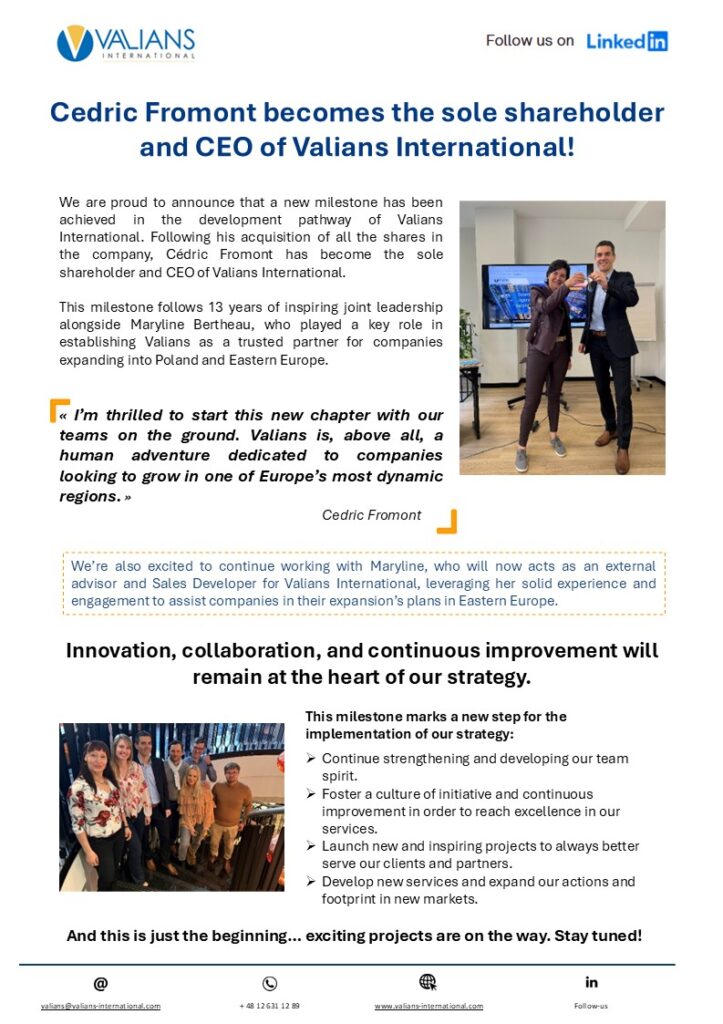
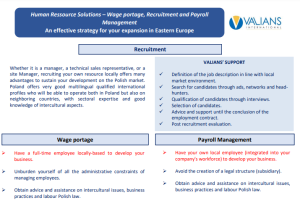

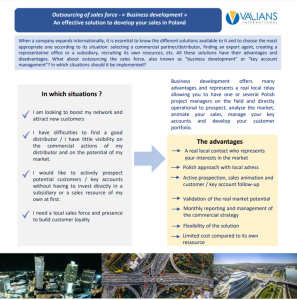
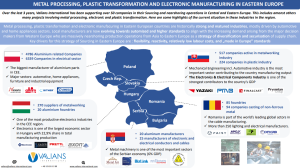
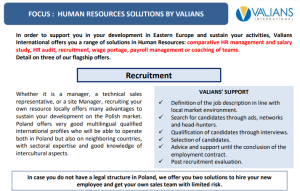
 (0048) 12 631 12 89
(0048) 12 631 12 89
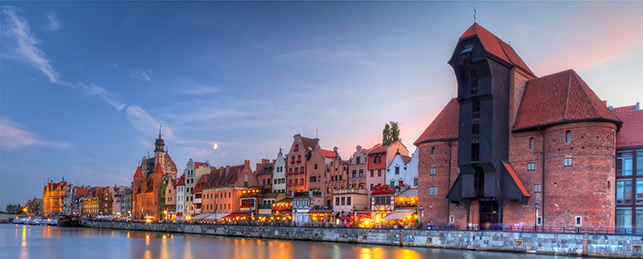
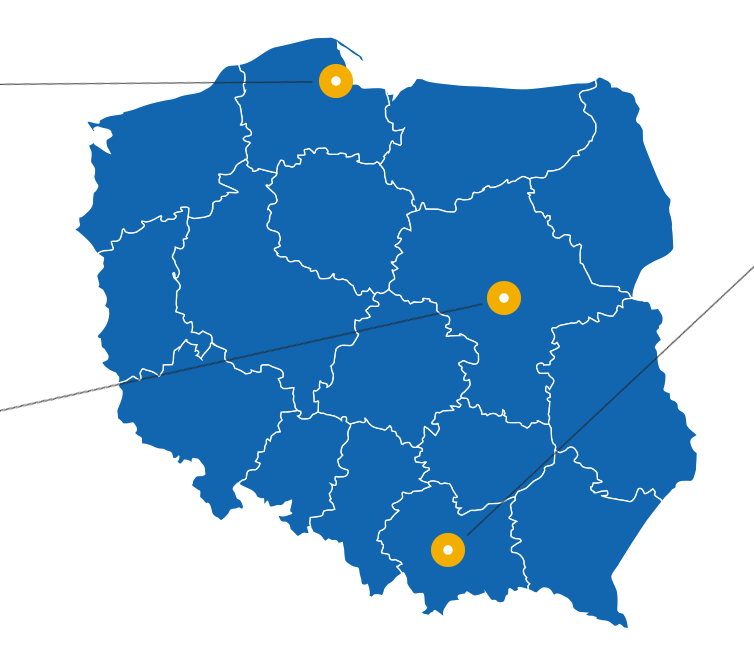


 (0048) 12 631 12 89
(0048) 12 631 12 89

